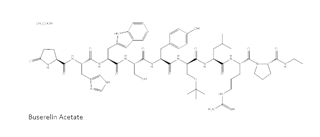
CAS Number: 68630-75-1
Formula: C60H86N16O13 .C2H4O2.
Molecular Weight: 1239.4 g/mol
Method of Analysis: Based on: BP
Application:
Prostate cancer or breast cancer, estrogen-dependent conditions (such as endometriosis or uterine fibroids), and in assisted reproduction (IVF)
Like other GnRH agonists, buserelin may be used in the treatment of hormone-responsive cancers such as prostate cancer or breast cancer, estrogen-dependent conditions (such as endometriosis or uterine fibroids), and in assisted reproduction
Mechanism:
Buserelin is a luteinizing hormone releasing hormone (LHRH) agonist. It is a synthetic analog of LHRH (also known as gonadotropin releasing hormone [GnRH]). LHRH agonists (LHRHa) initially stimulate the release of luteinizing hormone (LH, gonadotropin), resulting in a transient elevation in serum androgen in men and serum estradiol in women. However, chronic administration can cause down-regulation of the LHRH receptors, thus inhibiting the secretion of LH and ultimately the sex hormones (androgen, estradiol). By decreasing the testicular production of androgen in men, LHRHa can inhibit the growth of androgen-dependent prostate cancer. Similarly, LHRHa reduce the ovarian secretion of estradiol and progesterone in women, leading to inhibition of estrogen-dependent cancers. In men, LHRHa can reduce serum androgen to castrate level about 21 days after initiation of therapy. Similarly, serum estradiol level is suppressed in women around 4 weeks after initiation of treatment. LHRHa are 50-100 times more potent than LHRH. In addition, they have a longer duration of action due to increased receptor affinity and greater biological stability.
Storage conditions: Store between 2- 8o C protected from light
Packaging: glass vials